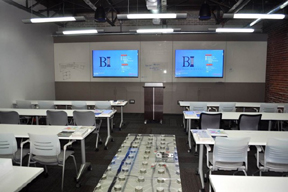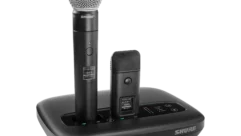
SVC Podcast – Show Notes – Show 142-2:
In this edition of the SVC Podcast, SVC Contributing Editor Bennett Liles wraps up his talk with Keith Gibson, Vice President of Sales and Engineering with Corona Integrated Systems about their installation of collaboration spaces, multi-purpose rooms and conference facilities for client Business Interiors. Keith outlines the changes in the specs that affected the project schedule and he discusses the differences between commercial and high-end residential AV projects.
Links of interest:
- LineQ, a full-service distributor specializing in complete Audio over IP solutions
- DIRTT, creating customizable, sustainable architectural interiors
- Savant Systems
- Vaddio
Download Podcast Here:
https://s3.amazonaws.com/nb-svc/public/public/141-2_Corona_Int_System_Bu…
From Sound & Video Contractor Magazine, this is the SVC Podcast with Keith Gibson. Show notes for the podcast are available on the web site of Sound & Video Contractor Magazine at svconline.com.
Business Interiors had a new facility that needed conference rooms, multi-purpose spaces and collaboration areas. Impressed with a previous residential job, they called in Corona Integrated Systems, and Vice President of Sales and Engineering Keith Gibson is going to tell us how they made it all work. That’s up next on the SVC Podcast.
Keith, it’s good to have you back with us for Part 2 on the SVC Podcast, Vice President of Sales and Engineering with Corona Integrated Systems in Birmingham and New Orleans. We were talking in Part 1 about the Business Interiors corporate client that you did some conference rooms and multi-purpose spaces for. I wanted to talk about the conference rooms and how they’re controlled. It’s not all the same copy-and-paste identical system is it?
Yes and no. You know, the whole reason we got this job to begin with was that the owner had used us before. We actually installed a Savant automation system in his home, so he was familiar with that particular product and he liked it and he wanted to know if we could use it in this facility. And so of course we said yes, we could make it work. It was a little bit of a challenge. Savant is mainly a residential product now and we were actually able to go in and integrate all these rooms together, even though it’s not a cookie-cutter system, and there’s a lot of unique pieces and parts that go along with it. But we integrated it well. It’s very simple and easy to use and doesn’t require a lot of training. You can just pick up your phone or your tablet and have that control. [Timestamp: 2:00]
And I think they had some preference for existing speakers. Did that make an overall difference in the sound of the space compared to the new speakers that were installed?
It did. In the past, like I mentioned earlier, they’d used the space temporarily as an event space. The place was so large they had just used inexpensive, Niles outdoor speakers. The problem was they had barely been used. It was an 8-ohm based system and they were using the large amplifier to drive those, a multi-channel amplifier. But we found out that there was some bridging and some other little surprises along the way. We also put in a variety of new speakers. We did some pendants and some other speakers from other manufacturers for 70-volt applications, and we were actually able to tune them and get them pretty close, via EQ, to sounding like they were all the same even though they all have different characteristics. [Timestamp: 2:56]
Well, that can be a tricky task trying to make vastly different speakers sound at least close to the same. We mentioned earlier the Ecler CA200z amplifiers and these things are very small, especially for what they do. What do you have for sources going into those amps?
It really depends on the room, but the majority of them you’ll have a computer that’s been supplied by the IT Department. Then we also have the Kramer VIA products, whether it’s a Connect PRO or Collage. Each one of those have their own unique capabilities. For example, with the Collages basically you have camera capabilities, you have external microphone capabilities, etc. So we actually used, for example, in one conference room for the owner, we used a Vaddio product, so we actually have hanging microphones from the ceiling. He didn’t want anything on the table, he wanted everything to be overhead. So we used the Vaddio piece and incorporated that with the Ecler product. And then we had cameras that go into the Kramer piece so that there is a two-way communication for when they need to do video conferencing with clients or other properties that they have across the south. [Timestamp: 4:06]
All right. So I know that there were multiple rooms here and perhaps architectural challenges on the wiring runs. What kind of a timeline were you working under? Did you run into anything that maybe threatened to put you behind?
Well, sure. By the time we actually got signed on to the job it was in October – the end of October – and they were already closing up walls. Now granted, the DIRTT product is very unique because it is like a Lego System; you can pull the walls off and on relatively easy with just a simple tool. But they also have a flooring system that raises things up just like an IP flooring system; but the uniqueness about theirs is it’s only about four inches high. So we were actually able to run wires and do things as changes occur relatively easy. However, nobody wants to go back and rechange other plans and everything, but it happened and allowed us to have a smooth transition to the changes that were being thrown at us. So we were actually able to get a lot of stuff done relatively fast because of the simplicity of the DIRTT system. [Timestamp: 5:12]
Yeah, that’s great when you can pull the floor up and put it back. Not always able to do that.
No. And the unique thing is that these are carpet tiles, I guess, on top of the flooring, so it makes it really, really simple when you had to do runs that you need to do. In fact, our installers would get frustrated because it’s not as easy to get through drywall get up into hot attics when they can just pull the floor and go that way. So there’s definitely some benefits that are there with the DIRTT product. [Timestamp: 5:40]
Now have your guys done installations in any live performance venues or is it mainly just residential and corporate?
Live venues and live performances spaces are a lot different than what you would encounter in a residential or commercial environment just because the live space is constantly moving and changing depending on performers, etc. So once you have the majority of your bulk product in place it’s a lot easier to make changes and move. For example, if you’re running snakes from front of house over to monitors or flying speakers, it’s a lot easier to say okay, I need an extra cable here and to go run that and make that change that you need to do compared to a real installation where you actually may have to go cut through 2×4’s, run across attics, and then clean up your wiring, etc. So it’s a little bit more thought about than I would say a live space is. [Timestamp: 6:36]
And I guess you don’t have to worry too much with client training on a live venue but on this one I would think that you had to provide some kind of training to the clients. My experience has been that as you move up the ladder of hierarchy the people tend to get a little less tech minded.
Well, that’s true. The good thing about the Savant system that we used here, and it’s just because of the ease of use. I can hand it to you – anybody that works in the building – and say okay, this is how you set a scene or this is how you turn on the lights or turn everything off when you leave the building. It’s super simple, and the functionality of being able for anybody to pick up their own device, whether it’s a phone or a tablet, and to have that control, makes things a lot easier. And so you don’t have to delegate certain responsibilities to certain people. If somebody comes in, say, at 5:00 in the morning, they can turn everything on and have it operational – and that’s the real benefit of it. [Timestamp: 7:30]
Yeah, it’s great when things are pretty much automated and they just press one button and the correct sequence of events happens. Who cares what goes on behind the scenes as long as it works when they push the button?
Yeah, the building comes alive with the push of a button.
So you got this one done and it sounds like everything went all right so what’s coming up next for Corona Integrated Systems? Have you got anything in the pipeline that you’re looking forward to?
We’re working with a government contractor getting ready to start a project in Florida that we’re looking forward to. The great thing about doing business with people like Business Interiors is that once their clients come in and see what we’ve done, it’s opened up a lot of other possibilities. So we’ve got a lot of clients that are coming in from Business Interiors as a result of doing this project where they’re saying, “We want the same thing – or maybe we want it better.” So we’ve got a couple of projects that are coming down the pipe that have actually gone above and beyond what we did for BI. So we’re looking forward to doing those projects here in the next several months. [Timestamp: 8:30]
That’s great when you have projects that sort of spin out of residential installation and then obviously every commercial project is an advertisement for itself, too.
That’s correct.
Well, I’m sure you had a good time on this one and I appreciate your telling us about it. Keith Gibson, Vice President of Sales and Engineering for Corona Integrated Systems. Thanks for telling us about the Business Interiors project. Sounds like it was fun.
It was a lot of fun, and so was this podcast. Thank you, Bennett, for allowing us the opportunity.
Thank you for being here with us for the SVC Podcast with Keith Gibson. Show notes are available on the website of Sound & Video Contractor Magazine at svconline.com. Be back with us for the next SVC Podcast.










